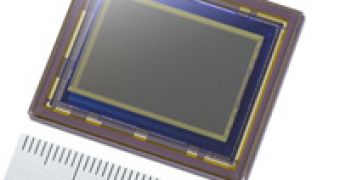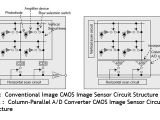The CMOS war between Canon and Sony has now entered the DSLR land. Last month, both companies announced their plans to invest in new facilities aimed at manufacturing more CMOS imagers. Back then, the big news was that CMOS units would eventually find their way into compact cameras.
A month later, Canon announced the EOS 1Ds Mark III, a 21.1MP full-frame beast, and the EOS 40D, an advanced 1.6x crop factor DSLR, both with CMOS sensors. The same day, Sony announces the commercialization of "IMX021", which is a new APS-C size CMOS imager with 12.47 effective megapixels and a new type of architecture that will supposedly improve speed and image quality.
Sony is touting a new technology called "Column-Parallel A/D Conversion Technique" that will provide each column within the sensor with its own A/D converter.
According to the press release, "this system enables analog signals transferred from the Sensor's vertical signal lines to be A/D converted directly, over the shortest possible distance. It also minimizes image degradation caused by the noise that arises during analog processing, while at the same time delivering an extremely high signal conversion speed (in all-pixel scan mode) of 10.39 frame/s (12 bit)".
Moreover, "since processing is performed in parallel for each column, even if the number of pixels or the frame rate increases, A/D conversion can be performed at significantly lower frequencies than with conventional non-parallel circuit structures. Consequently, high picture quality digital signals can be processed without the noise interference that results from high frequency signals."
The press release also mentions that "the "Column-Parallel A/D Conversion Technique" aligns both digital and CDS circuits alongside each column. Column-parallel digital CDS circuits reduce not only pixel noise, but also the noise and inter-column processing variations that can affect analog CDS circuits. These circuits also limit A/D converter fluctuations. With this dual noise cancelling technology realizing high-precision noise reduction across both analog and digital circuits, the "IMX021" image sensor allows signals to be transferred, with limited noise, to the image processing circuits of the camera unit itself. This makes it ideally suited for the development of high image quality digital SLR cameras."
But enough with the technical details! The important thing is that Sony will use this new sensor in its DSLRs to come and will also probably sell it to others, most likely Nikon. Speaking of Nikon, Canon's latest announcements have really put the makers of the D2X and D200 in a tight spot. They need to refresh their lineup as soon as possible or else, Canon will eventually take over completely the advanced and professional segments.
Sony is also rumored to prepare some interesting DSLRs and there are also some who say that there's a partnership with Nikon to steal some of Canon's market share, but these are just speculations for now.
Features
- CDS/PGA Circuit, 12bit-AD Converter on chip PGA: Programmable Gain Amplifier - 12 channel parallel LVDS output - Readout mode: - All-pixel scan mode (12 bit:10.39 frame/s) - Window readout
We are just a few, but there are many of you, Softpedia users, out there. That's why we thought it would be a good idea to create an email address for you to help us a little in finding gadgets we missed. Interesting links are bound to be posted with recognition going mainly to those who submit. The address is  .
.

 14 DAY TRIAL //
14 DAY TRIAL // 
